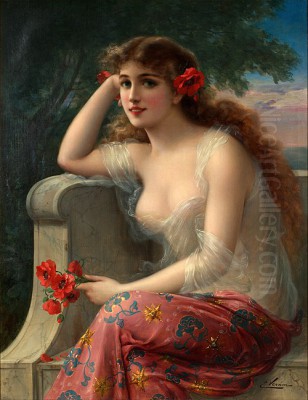
The period in French history known as the Belle Époque, stretching roughly from the 1870s to the outbreak of World War I in 1914, was a time of relative peace, prosperity, and vibrant cultural output in Paris. It was an era of optimism, artistic innovation, and a particular appreciation for beauty, elegance, and the joys of life. Within this flourishing artistic landscape, Paul Émile Vernon, known professionally as Émile Vernon, emerged as a distinctive voice, celebrated for his enchanting depictions of women and children, rendered with remarkable technical skill and a signature luminous charm. Though his career was relatively brief, cut short by his early death, Vernon left behind a body of work that continues to captivate audiences with its idealized beauty and gentle sentiment.
Early Life and Artistic Formation
Paul Émile Vernon was born on March 14, 1872, in Blois, a historic city nestled in the picturesque Loire Valley of France. His artistic inclinations manifested early. He pursued formal training at the École des Beaux-Arts in Tours, a significant regional art school. There, he honed his foundational skills, particularly in drawing, demonstrating considerable talent. His dedication was recognized in 1888 when he was awarded the first prize for drawing, an early indicator of the technical proficiency that would characterize his later work.
Seeking to further his artistic education and immerse himself in the heart of the French art world, Vernon moved to Paris. The capital was then the undisputed center of Western art, bustling with academies, salons, and avant-garde movements. Vernon, however, chose a path aligned with the established academic tradition. He sought instruction from some of the most respected figures of the French artistic establishment.
His most significant mentor was William-Adolphe Bouguereau, a towering figure in 19th-century French Academic painting. Bouguereau was renowned for his highly polished, technically flawless paintings, often depicting mythological or idyllic genre scenes featuring idealized figures. Studying under Bouguereau provided Vernon with rigorous training in classical drawing, anatomy, composition, and the smooth, meticulous application of paint that defined the academic style. This influence is clearly visible in Vernon's own emphasis on refined finishes and idealized subjects.
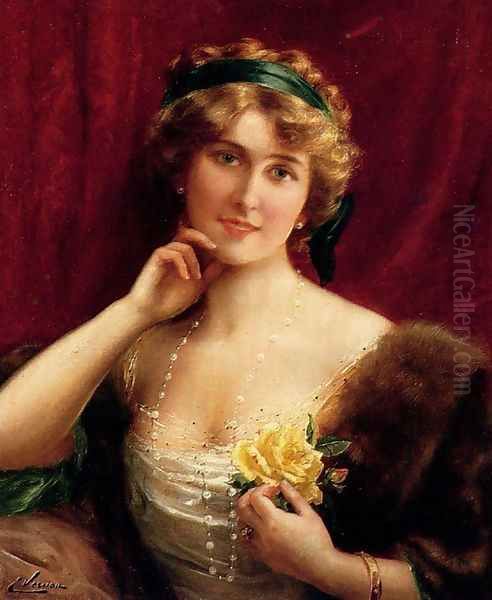
Vernon also studied with Auguste Delaunay, another respected artist and professor associated with the academic system. Through these masters, Vernon absorbed the core tenets of Academic art: a strong emphasis on draftsmanship, a commitment to representational accuracy (albeit often idealized), and the creation of harmonious, well-composed images intended to appeal to both the eye and the sentiment of the viewer. This solid academic grounding provided the technical foundation upon which Vernon would build his distinct artistic identity.
Debut and Early Recognition
Armed with a strong academic foundation and a developing personal style, Émile Vernon was ready to present his work to the public. The primary venue for ambitious artists in Paris was the official Salon, an annual (or biennial) exhibition organized by the Société des Artistes Français. Acceptance into the Salon was crucial for establishing a reputation and attracting patrons. Vernon made his debut at the Paris Salon in 1898. This marked his formal entry into the professional art world of the French capital.
His early works quickly garnered attention. He specialized in subjects that were highly popular during the Belle Époque: charming portraits, particularly of women and children, and vibrant floral still lifes. His paintings stood out for their bright palettes, delicate execution, and the sheer attractiveness of his subjects. He possessed a talent for capturing a sense of youthful innocence, feminine grace, and the ephemeral beauty of flowers, all rendered with a palpable sense of joy and optimism.
Vernon's reputation continued to grow. A significant moment of recognition reportedly occurred in 1904 when his painting titled Roses was exhibited at the prestigious Royal Academy of Arts in London. According to some accounts, the work caused a sensation, admired for its technical brilliance and sentimental appeal. Its success allegedly cemented his status as a noteworthy artist within the broader European context, associating him with the meticulous realism and idealized subject matter favored by academic painters of the era. While Salon participation was the primary goal for French artists, exhibition in London indicated a broadening of his reach and appeal.
Artistic Style and Philosophy
Émile Vernon's art is firmly rooted in the French Academic tradition, yet it possesses a distinct charm and lightness that sets it apart. His style is characterized by a combination of meticulous realism, particularly in rendering faces, fabrics, and flowers, and an overall idealized, often sentimental, vision. He was a superb draftsman, a skill honed under Bouguereau, evident in the clear definition of forms and the graceful poses of his figures.
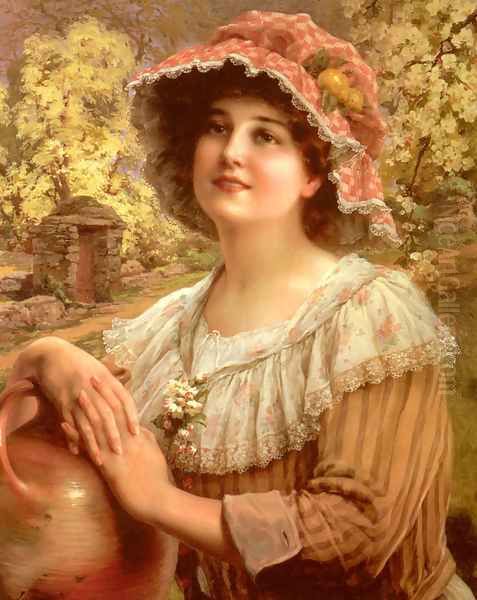
Color is a defining element of Vernon's work. He employed a bright, luminous palette, often favoring soft pastels, vibrant pinks, reds, and pure whites, contrasted with lush greens and deep shadows. His use of color contributes significantly to the cheerful and optimistic mood that pervades many of his paintings. He handled light with great skill, often depicting his subjects bathed in soft, natural sunlight, which enhances the sense of warmth and vitality. The interplay of light and shadow is used not just for modeling form but also for creating atmosphere, often lending a slightly dreamlike or idyllic quality to the scenes.
His brushwork is typically smooth and refined, especially in the rendering of skin and delicate textures like flower petals or silk ribbons, reflecting his academic training. However, in backgrounds or floral elements, his touch could sometimes be slightly looser and more painterly, adding vibrancy and preventing the compositions from becoming overly stiff. This blend of tight rendering in focal points and slightly freer handling elsewhere contributes to the lively quality of his work.
Philosophically, Vernon's art seems dedicated to the celebration of beauty, innocence, and simple pleasures. His subjects are invariably pleasant and untroubled. He focused on the positive aspects of life, capturing moments of quiet joy, contemplation, or playful interaction. There is little evidence of social commentary or engagement with the darker aspects of human existence in his known oeuvre. Instead, his work offers an escape into a world of perpetual springtime, youthful beauty, and gentle emotions, perfectly aligning with the escapist and aesthetic sensibilities prevalent during the Belle Époque. His style can be seen as a fusion of Academic realism with elements of Romantic sentimentality, resulting in works that are both technically accomplished and emotionally appealing.
Themes and Subjects: A Celebration of Femininity and Youth
The recurring themes in Émile Vernon's art revolve around idealized femininity and childhood innocence, often intertwined with the beauty of nature, particularly flowers. His most frequent subjects were young women and girls, depicted with a characteristic sweetness and grace. These figures are often portrayed in moments of quiet reflection, engaging in gentle activities like reading, arranging flowers, or simply gazing out at the viewer with a serene or slightly coquettish expression.
Vernon excelled at capturing the delicate features and fresh complexions of his models. He paid close attention to details of fashion, depicting the elegant dresses, elaborate hats adorned with ribbons and flowers, and hairstyles popular during the Belle Époque. These details not only add visual interest but also firmly place his work within its specific historical and cultural context. His female figures often embody contemporary ideals of beauty – graceful, refined, and radiating a certain innocent charm.
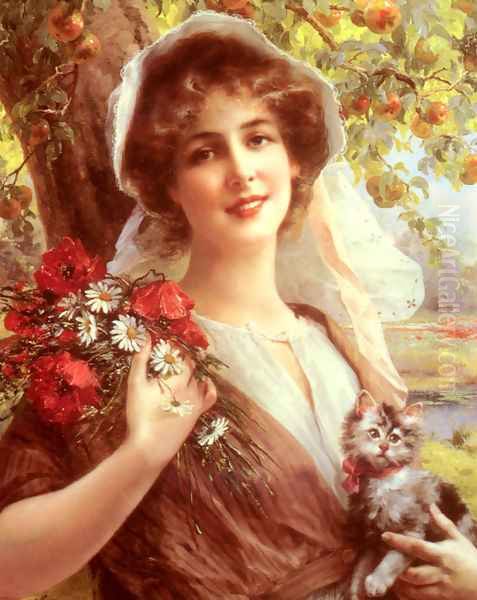
Children were another favorite subject. He painted them with tenderness, emphasizing their wide-eyed innocence and playful nature. Often depicted interacting with pets, gathering flowers, or simply posing in charming outfits, his child portraits evoke a sense of nostalgia for a carefree, idyllic youth. Works like Girl Holding a Bird's Nest exemplify this theme, combining the depiction of childhood innocence with a connection to the natural world.
Flowers play a crucial role in Vernon's compositions, functioning almost as secondary subjects. He was a masterful painter of floral arrangements and natural settings. Roses, lilacs, cherries, poppies, and other blossoms frequently adorn his figures' hats, fill vases in the background, or cascade around them in garden settings. These floral elements enhance the decorative quality of his paintings and symbolize themes of beauty, youth, and the transience of life. His skill in rendering the delicate textures and vibrant colors of flowers is remarkable.
It is noted that Vernon drew personal inspiration from his own family, particularly his wife and daughter. This personal connection may account for the intimacy and genuine tenderness often perceived in his depictions of women and children. His work seems to be a heartfelt celebration of the feminine sphere and the perceived innocence of youth, presented through the lens of late 19th and early 20th-century aesthetic ideals.
Key Works and Analysis
Several paintings stand out in Émile Vernon's oeuvre, exemplifying his style and thematic concerns:
Roses (1904): This painting, reportedly exhibited to acclaim at the Royal Academy in London, is often cited as a key work. While specific images widely identified as the 1904 Roses can be elusive, Vernon painted numerous works featuring women and roses. Typically, these depict beautiful young women adorned with or holding roses, showcasing his skill in rendering both delicate complexions and intricate floral details. Such works would embody his focus on feminine beauty intertwined with nature, executed with the polished finish expected of academic painting. Its reported success suggests it struck a chord with contemporary tastes for idealized beauty and technical virtuosity.
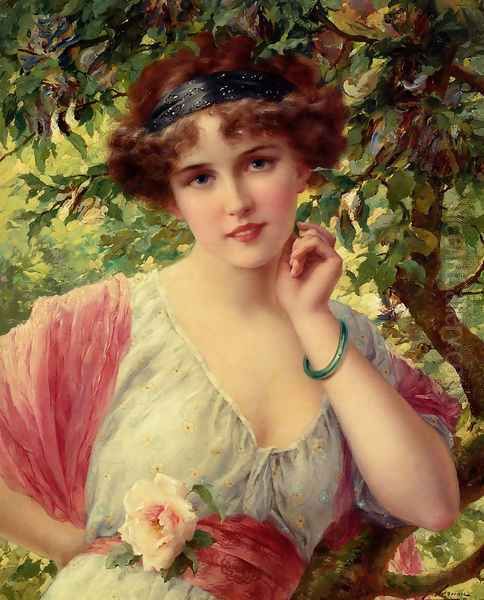
Girl Holding a Bird's Nest (1913): This is arguably one of Vernon's most famous and frequently reproduced images. It depicts a young girl with reddish-blonde hair, wearing a white dress and a straw hat adorned with pink ribbons, gently holding a bird's nest containing small blue eggs. Her expression is one of tender curiosity and care. The painting masterfully captures the innocence and gentleness of childhood, set against a softly focused natural background. The composition is intimate, the colors are soft and harmonious, and the handling of light creates a warm, idyllic atmosphere. It perfectly encapsulates Vernon's ability to convey sentiment without becoming overly saccharine.
Country Spring (c. 1900s): Vernon painted several works evoking the seasons. Country Spring likely depicts a young woman or child in an outdoor setting, surrounded by the fresh blossoms and vibrant greens associated with springtime. Such works typically convey a sense of renewal, hope, and the tranquil beauty of nature. Vernon would use his characteristic bright palette and attention to floral detail to capture the essence of the season, often imbuing the scene with a feeling of optimism and peacefulness.
Country Summer (c. 1900s / possibly 1916): Similar to Country Spring, works titled Country Summer would focus on the abundance and warmth of the summer months. Expect depictions of figures in sunlit gardens or fields, perhaps amidst ripe fruit or blooming flowers like poppies or sunflowers. These paintings often emphasize the leisurely pace and pleasant atmosphere associated with summer, rendered in Vernon's typically bright and cheerful style. Summer Roses (1916) is another example focusing on this seasonal theme combined with his favorite floral motif.
Under the Cherry Tree / Serene Beauty Under the Cherry Tree (1900): This work is noted for its pink tones and dreamlike quality. It likely portrays a woman or girl seated beneath a blossoming cherry tree, a classic symbol of spring and transient beauty, particularly in Japonisme-influenced art circles of the time. The emphasis on pink hues and a soft, perhaps slightly hazy atmosphere would enhance the poetic and romantic feel, showcasing Vernon's ability to create mood through color and light.
Three Sisters (1897): An earlier work, this painting likely demonstrates his developing skill in portraiture and multi-figure composition shortly before his official Salon debut. It probably depicts three young women, possibly siblings, showcasing familial bonds and individual personalities within a harmonious group setting. Such a work would highlight his ability to handle complex compositions while maintaining his focus on graceful figures and pleasing aesthetics.
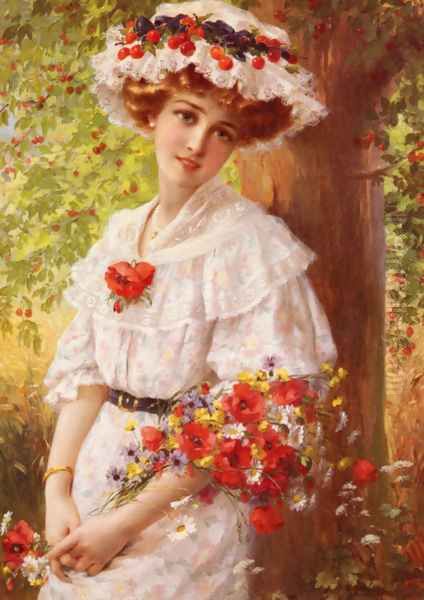
Other notable titles mentioned in various sources include The Cherry Bonnet, Among The Blossoms, Young Woman with Lilacs, Dragonfly, Naughty Puppy, and Girl with Yellow Roses. Each title suggests a continuation of his preferred themes: charming figures, often young women or children, interacting with elements of nature or pets, always presented with elegance and vibrant color. These works collectively demonstrate Vernon's consistent dedication to capturing idealized beauty and gentle sentiment throughout his career.
Context and Connections: Vernon in the Belle Époque Art World
Émile Vernon worked during a period of significant transition and diversity in the art world. While he remained faithful to the Academic tradition, the late 19th and early 20th centuries saw the rise and consolidation of Impressionism, Post-Impressionism, Fauvism, and the beginnings of Cubism. Vernon's art existed alongside, yet stylistically apart from, these revolutionary movements.
His primary artistic lineage connects directly back to the masters of French Academicism. His teacher, William-Adolphe Bouguereau (1825-1905), was perhaps the most successful and emblematic Salon painter of his generation, whose influence on Vernon's polished technique and idealized subject matter is undeniable. Other major figures of the Academic establishment whose work shares characteristics with Vernon's, or who represented the dominant Salon aesthetic he engaged with, include Jules Joseph Lefebvre (1836-1911), known for his elegant female nudes and portraits, and Jean-Léon Gérôme (1824-1904), famous for his historical and Orientalist scenes executed with photographic precision. Earlier figures like Alexandre Cabanel (1823-1889), whose Birth of Venus was a sensation at the Salon of 1863, also set precedents for the kind of sensual yet idealized female figures that populated academic art.
Vernon's focus on portraiture, particularly of elegant women, also places him in dialogue with other successful portraitists of the era, though his style remained generally sweeter and less psychologically probing than some. Figures like Léon Bonnat (1833-1922) and Carolus-Duran (1837-1917) were highly sought-after portrait painters working in a more robust, realistic vein. The dazzling society portraits of Giovanni Boldini (1842-1931), with their dynamic brushwork, or the elegant depictions of modern life by James Tissot (1836-1902), offer contemporary comparisons, highlighting Vernon's comparatively gentler, more idealized approach. Even the internationally renowned John Singer Sargent (1856-1925), while often more bravura in technique, sometimes captured a similar sense of Belle Époque elegance.

It is important to remember that while Vernon adhered to academic principles, the avant-garde was forging new paths. Claude Monet (1840-1926) was exploring the effects of light and color in his Impressionist landscapes, Edgar Degas (1834-1917) captured modern Parisian life with unconventional compositions, and Pierre-Auguste Renoir (1841-1919), though sometimes sharing Vernon's interest in charming female subjects, did so with a characteristically Impressionist touch. The subsequent generation, including Vincent van Gogh (1853-1890) and Paul Gauguin (1848-1903), pushed artistic expression even further from academic norms. Vernon's commitment to traditional techniques and idealized subjects placed him firmly within the established Salon system, which, despite the rise of the avant-garde, continued to command significant prestige and patronage throughout the Belle Époque. He did not appear to be part of any specific artistic group or movement beyond the broad category of academic or Salon painters. His teacher Auguste Delaunay (1828-1891), primarily known as an engraver but also a painter and professor, further solidifies Vernon's connection to the official art institutions.
Later Life and Legacy
Émile Vernon continued to paint and exhibit his work into the early 20th century. His subjects remained consistent, focusing on the themes of feminine beauty, childhood innocence, and floral abundance that had brought him success. He maintained a high level of technical skill and continued to produce works characterized by their vibrant color and charming appeal.
Tragically, Émile Vernon's life and career were cut short. He died in 1920 at the relatively young age of 48. The exact circumstances of his death are not widely documented, but his passing occurred just as the world was emerging from the trauma of World War I and the Belle Époque era had definitively drawn to a close. The artistic tastes of the post-war era began to shift dramatically, moving further towards Modernism and away from the idealized aesthetics of the pre-war academic tradition.
Despite the changing artistic landscape, Vernon's work retained a certain appeal. His paintings, with their optimistic outlook and celebration of beauty, offered a nostalgic glimpse into a seemingly more gracious and untroubled time. His technical proficiency remained undeniable, and the inherent charm of his subjects continued to attract admirers.
Today, Émile Vernon is recognized as a significant practitioner of late Academic painting, particularly noted for his specialization in portraits of women and children. While perhaps not an innovator in the mold of the Impressionists or Post-Impressionists, he excelled within his chosen genre. His work is appreciated for its consummate skill, its decorative qualities, and its embodiment of the Belle Époque's aesthetic ideals. His paintings continue to be popular on the art market, sought after by collectors who appreciate their beauty and nostalgic charm. His legacy lies in his ability to capture, with exceptional skill and sensitivity, a particular vision of idealized femininity and childhood innocence that resonated strongly with his contemporaries and still finds an appreciative audience today.
Exhibitions and Collections
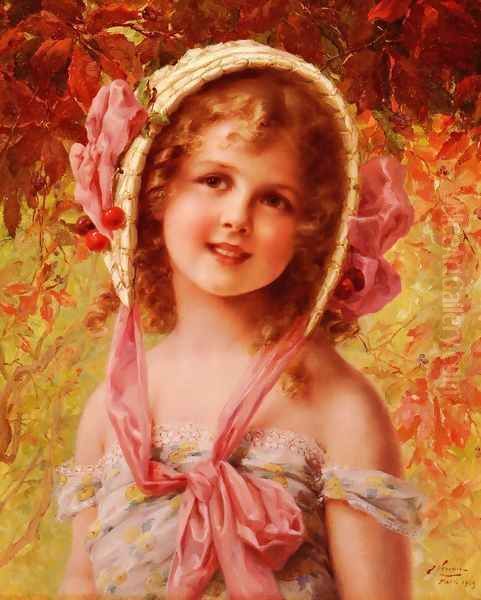
Throughout his career, Émile Vernon actively participated in the established art exhibition system of his time. His debut at the Paris Salon in 1898 was a critical step, and he likely continued to submit works to the Salon in subsequent years, as this was the primary venue for academic artists to gain visibility and commissions in France.
His reported exhibition of the painting Roses at the Royal Academy of Arts in London in 1904 suggests an effort to reach an international audience. The Royal Academy was, and remains, a prestigious institution, and exhibiting there would have been a significant achievement, exposing his work to British collectors and critics.
While specific records of every exhibition Vernon participated in may be scarce, his consistent output and the popularity of his style suggest his work was likely shown in various galleries in Paris and potentially other European cities during his lifetime. Galleries specializing in academic and genre painting would have been natural venues for his work. Some sources mention his works being displayed in Parisian galleries, potentially including venues like the "Paris Leo Art Museum," although verification of this specific name as a major institution requires caution; it might refer to a commercial gallery active at the time or a later entity handling his estate.
After his death, Vernon's paintings largely fell out of critical favor during the dominance of Modernism in the mid-20th century. However, there has been a resurgence of interest in academic art from the 19th and early 20th centuries since the later decades of the 20th century. Vernon's works have reappeared in galleries and at auction houses, often fetching substantial prices.
His paintings are held in numerous private collections around the world. Sources indicate a particular interest among collectors in the United States, Canada, and Japan, demonstrating the broad international appeal of his charming and technically accomplished style. While perhaps not heavily represented in major public museum collections compared to leading avant-garde figures, his work is actively traded and appreciated within the market for traditional European painting. The enduring popularity of reproductions of his most beloved images, like Girl Holding a Bird's Nest, further attests to his lasting appeal to a wide audience.
Conclusion: An Enduring Vision of Grace
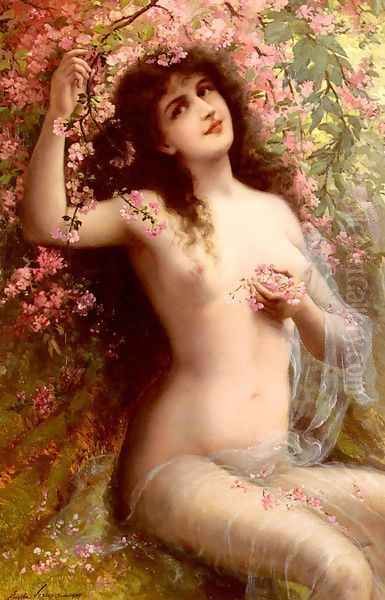
Émile Vernon stands as a quintessential painter of the Belle Époque's optimistic spirit. Working within the French Academic tradition, he carved a niche for himself through his enchanting depictions of women, children, and flowers. His art is characterized by a luminous palette, delicate brushwork, and an unwavering focus on idealized beauty, innocence, and grace. Trained by masters like William-Adolphe Bouguereau, he possessed formidable technical skill, which he employed to create images that are both meticulously rendered and emotionally resonant.
While living and working during a time of radical artistic experimentation, Vernon remained committed to the established principles of harmony, beauty, and fine craftsmanship. His paintings offer a window into a world perceived as elegant, gentle, and perpetually in bloom – a vision that held great appeal for his contemporaries and continues to charm viewers today. Though his life was relatively short, Émile Vernon left behind a legacy of beautiful images that celebrate femininity, childhood, and the simple joys of life, securing his place as a beloved, if specialized, master of his era. His work remains a testament to the enduring power of skillfully executed paintings that aim, above all, to delight the eye and warm the heart.